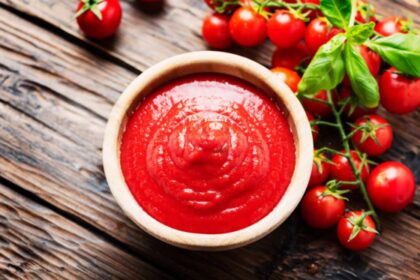Eating plenty of fruits & vegetables is a cornerstone of a healthy diet. However, the common wisdom that raw produce is always the most nutritious has recently been challenged. Cooking breaks down plant cell walls and other compounds that can inhibit nutrient absorption when certain fruits and vegetables are eaten raw.
For some produce, cooking can actually boost the bioavailability of important vitamins, antioxidants, and minerals. While raw vegetables and fruits certainly have benefits, there are times when cooking them allows us to maximize the nutrition we extract from these plant foods.
In this article, we will explore 10 specific fruits and vegetables that provide more absorbable nutrients when cooked rather than raw. For each food, we will explain the key nutrients enhanced by cooking, the compounds that can inhibit nutrient absorption when eaten raw, and the cooking methods that best preserve nutrients.
For example, cooking breaks down the cell walls in tomatoes to release more lycopene, an antioxidant that is better absorbed by our bodies when tomatoes are prepared rather than eaten raw. With carrots, heat allows us to better absorb antioxidant compounds like beta-carotene that are locked behind rigid plant cell walls when carrots are raw.
Beyond looking at individual fruits and vegetables, we will also discuss broad cooking techniques that can boost nutrient availability. Methods like sautéing, roasting, steaming and blanching all have different impacts on plant compounds and cell walls. Understanding the science behind how cooking affects fruits and vegetables can help us maximize the nutrition we extract from produce.
While raw foods certainly have a place in a healthy lifestyle, cooking is also an important tool for getting the most from fresh produce. The key is using appropriate techniques for each specific fruit or vegetable.
Continuing reading to learn which 10 plant foods provide the biggest nutrient absorption boost when cooked. We’ll provide you with actionable advice on the best cooking methods to preserve nutrients and make their key vitamins, antioxidants, and minerals more bioavailable. With science-backed cooking tips and techniques, you’ll be able to get more nutritional value from the important fruits and vegetables you include in your diet.
10 Fruits & Vegetables That Are Healthier When Cooked
-
Tomatoes
Cooking tomatoes significantly increases available lycopene levels. Lycopene is a potent antioxidant that reduces prostate cancer risk and supports cardiovascular health.
One study found that simmering tomatoes in olive oil for just 2 minutes tripled bioavailable lycopene due to disrupted cell walls. Oven roasting tomatoes has also been shown to boost lycopene concentrations as the antioxidant syntheses during heating.
Raw tomatoes contain enzymes like pectin methylesterase that can degrade nutrients upon ingestion. They also contain anti-nutrient glycoalkaloids like tomatine that can inhibit lycopene absorption when consumed frequently.
To maximize lycopene availability, try simmering canned or fresh tomatoes for a few minutes, roasting chopped tomatoes at 200°F until soft, or lightly sautéing cherry tomatoes in olive oil over medium heat. -
Carrots
Beta-carotene gives carrots their bright orange hue. This antioxidant carotenoid converts to active vitamin A in the body to support immune function, eye health, and cell growth.
Research finds that steaming carrots for 3-4 minutes can triple absorbable beta-carotene compared to raw carrots. Boiling can increase beta-carotene bioavailability by over 25%.
Carrots’ rigid cell walls made of cellulose and pectin limit accessibility to carotenoids during digestion. Cooking gently disrupts these structures, releasing more antioxidants.
Quick steaming, light boiling, or roasting carrots whole or in cubes helps boost beta-carotene levels. Avoid overcooking carrots to prevent leaching of water-soluble nutrients like vitamin C and B vitamins. -
Spinach
Lightly cooking spinach helps release more antioxidants like lutein, zeaxanthin, and vitamin E by breaking down plant cell walls. Steaming spinach for just 1-2 minutes has been shown to increase folate bioavailability by over 150%.
Cooking also significantly reduces levels of oxalic acid, a compound that can bind minerals like calcium and inhibit absorption. Boiling spinach causes the most oxalic acid loss, but steaming is gentler at preserving nutrients while still degrading anti-nutrient compounds. Quick sautéing or steaming spinach helps boost antioxidant and mineral absorption.
Get all the beneficial nutrients without the taste or texture by adding Organic Spinach Powder By Micro Ingredients to your smoothies. Click Here To Check It Out. -
Broccoli
Research indicates that steaming broccoli for 3-5 minutes can increase available glucosinolate concentrations by around 20% compared to raw broccoli. Glucosinolates are sulfur-rich antioxidants found abundantly in cruciferous vegetables like broccoli.
Myrosinase enzymes convert glucosinolates into active compounds like sulforaphane that have demonstrated anti-cancer effects in studies. Cooking broccoli gently deactivates myrosinase while still allowing glucosinolate conversion when consumed.
Conversely, boiling broccoli can reduce glucosinolates by over a third due to leaching into cooking water. For maximum glucosinolate preservation and activation, steam broccoli spears until just fork tender or roast florets under 400°F.
Organic Freeze Dried Broccoli Powder Is Packed With Antioxidants, Add To Your Soups And Smoothies. Click Here To Check It Out! -
Asparagus
Both cooking and fermentation can dramatically increase the bioavailability of potent antioxidants in asparagus like quercetin. These compounds are housed in robust cell walls made indigestible by thick cellulose fibers.
Studies show that steaming or pan-frying asparagus spears for 3-4 minutes increases phenolic antioxidant absorption by over 25% compared to raw. The heat and moisture begin to break down the vegetable’s rigid cell walls.
Fermented and pickled asparagus products also display enhanced digestion of antioxidants like rutin. Quickly steam, sauté, or marinate asparagus to maximize nutrient availability. -
Mushrooms
Mushrooms contain a diverse array of bioactive compounds with antioxidant and anti-inflammatory properties. However, the tough chitin present in mushrooms’ cell walls can inhibit nutrient absorption when eaten raw.
Research demonstrates that cooking mushrooms for even 5 minutes increases immune-boosting antioxidant availability by over 30%. As cooking time increases, chemical degradation accelerates, so shorter cooking durations are preferred.
Lightly sautéing mushrooms for a few minutes before adding to dishes helps balance digestibility with preserving delicate nutrients. Avoid microwaving mushrooms, which provided minimal increases in antioxidant activity in one study.
Organic Mega Mushroom Powder Is Packed With 10 Nutrient Dense Mushrooms And Great To Mix Into Coffee Or Smoothies. Click Here To Check It Out! -
Peppers
Brightly colored bell peppers house abundant antioxidant carotenoids like beta-carotene and lutein. The tough skin and inner cell walls of peppers are highly indigestible when eaten raw, so cooking provides significant improvements in bioavailability.
One study found that roasting red peppers increased carotenoid absorption almost 15 times compared to raw peppers. Cooking causes structural changes that disrupt the cell walls, making health-promoting compounds more accessible. To maximize carotenoid availability from peppers, try roasting, grilling, or lightly steaming until just tender. -
Garlic
Raw garlic contains high levels of allicin, an organosulfur compound with potent medicinal properties. However, allicin is highly unstable and quickly degrades into other healthful antioxidant organosulfides when exposed to heat. Allowing chopped garlic to rest for 5-10 minutes before cooking enhances this conversion.
Studies show that oven baking garlic for 15 minutes significantly increased antioxidant activity and circulation-boosting effects compared to raw garlic. Gently cooking crushed or chopped garlic in soups, sautés, and stews helps augment the benefits of this superfood. Check Out This Odorless Garlic Supplement For All The Benefits Of Garlic Without The Smell Or Taste. -
Eggplant
Eggplant contains a class of antioxidants called nasunin in its purple pigment. Nasunin contributes to brain and heart health. However, raw eggplant also contains solanine glycoalkaloids that can inhibit digestion when consumed in excess.
Cooking eggplant significantly reduces solanine content while increasing antioxidant availability. One study found that boiling eggplant reduced solanine glycoalkaloids by 92% after 30 minutes. Try grilling, roasting, or lightly frying eggplant slices to maximize nutritional benefits. -
Zucchini
This summer squash is rich in antioxidant carotenoids like lutein and zeaxanthin. Steaming zucchini for just two minutes significantly increases the activity of these vision-protecting antioxidants.
Cooking methods like steaming, sautéing, and roasting all effectively soften zucchini’s cell walls, boosting absorption of nutrients like vitamin C while avoiding leaching from boiling. Lightly cook zucchini to release more of its beneficial antioxidants and vitamins.In conclusion, many fruits and vegetables provide enhanced nutrient availability when prepared properly cooked rather than eaten raw. Understanding the effects of heating, fermentation, and cooking techniques allows us to maximize the nutritional value from produce. Incorporating a balance of raw and gently cooked fruits and vegetables into your diet helps optimize intake of vitamins, antioxidants, and minerals that support optimal health.
Cooking can unlock more nutrients in fruits and vegetables that would otherwise remain trapped behind tough cell walls when eaten raw. As we’ve explored, proper preparation techniques can maximize the availability of antioxidants, vitamins and minerals in plant foods through the strategic application of heat.
Methods like light steaming, quick sautéing, gentle roasting and low-temperature blanching break down fibers and anti-nutrient compounds while retaining delicate nutrients. Each fruit and vegetable responds differently to various cooking techniques. Understanding these effects lets you tailor preparation methods to boost absorption of beneficial plant compounds.
While raw produce has nutritional merits, gentle cooking enhances the bioavailability of many phytonutrients. Incorporating a mixture of both raw and thoughtfully cooked fruits and vegetables into your diet is ideal for comprehensive nutrient intake.
Mix up your salad with quick-sautéed mushrooms and roasted peppers. Lightly steam broccoli to accompany fresh grapefruit. The possibilities are endless when thoughtfully preparing plant foods to optimize their gifts. With evidence-based knowledge and a bit of kitchen wisdom, we can unlock more of the wholesome nutrition within our foods that nature intended.





